Volta at Mercer
An independent gallerist explained to me that the growing financial imperative to participate in art fairs relates, at least partially, to diminishing foot traffic in the physical galleries themselves. Among art fairs, Volta stands out for the human scale of its presentation with each gallery (often a small, one person operation) showing only the work of a single artist.
_______________
_______________
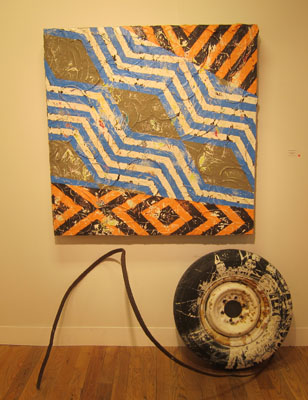
Duhirwe Rushemeza’s partial incorporation of rhythmic patterning might at first tempt a casual viewer to associate these pieces with printed fabric, decoration, printmaking, or the, finally, more simplistic distillations aspired to in so much geometric abstraction. However, the tensions elicited through the way she integrates contrary tendencies of direction, weight, movement and surface shout more deeply – and much more painterly – than where any of those quick preconceptions might lead. There’s a distinct visual pulse. Rushemeza’s procedures closely emulate the archetypal layering, memory, absorbency, and concurrent weathering of the public wall with a great affinity for that plastic space so unlike the illusions of air effected through illustrational painting. Although the Pan-African aesthetics of the work were clearly evident, I also learned in conversation that, although not so discernible visually, that they are also to be understood as packed with metaphors of postcolonial experience, displacement, immigration, polarizing histories and ephemerality. Their affirmative confidence, however, exude with adventure well beyond the confines of lament or despair.
_______________
_______________
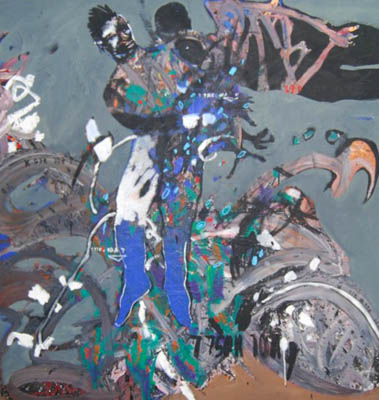
Where collage assumes fragmentation and an indissoluble separateness of its constituents, the kind of visual space I see in Soly Cissé’s paintings seems to allow for an interpenetration of concurrent worlds that needn’t be roped within a single controlling order, nor are they unaware of each other. Cissé paints a polyglot simultaneity. Masses of probing loose strokes at abstract scale, human and animal figures, flat monochrome regions, dashes of coded numbers, letters and text can coexist on a single canvas without coming across as an eclectic essay on stylistic alternatives or some “critical crisis,” but rather, as different varieties of consciousness all allowed their visible articulation. I don’t think that he accepts distinct separations among them. His father set broken bones, I was told – and that x-ray images have long frequented Soly’s own visual lexicon. There’s a looking through, looking within, looking under. I believe he’s really on to something.
_______________
_______________
Willie Cole stuns with his virtuosity. Although there’s no absence of highly adept technical finesse, his truly incendiary virtuosity is of the imagination. This is the fire of betrayed and kidnapped descendants of the great classical cultures of Kongo, Yorubaland and elsewhere in Africa, who, in the Americas, collectively honed the transcendent skill of making something out of nothing into high art. Cook’s vision walks the talk of William Blake’s “world in a grain of sand.” The high palm sleight of the maestro magician.
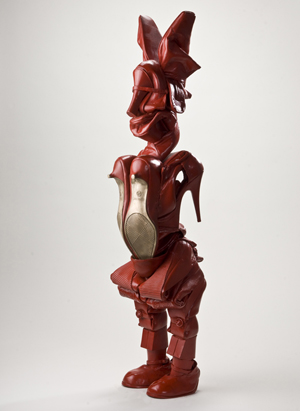
A shoe is a shoe is a shoe. And this high heel shoe that knows the street, the club, the party, the salon, the foot, the walk, the dance, the strut, keeps tab on its memory too. It can see across the Atlantic, perhaps just a bit north of the equator. Present tense. Continuous. The shoe multiplies, bends, shapes, combines. Face. Figure. Ears. Trickster rabbit. Birds. Bad girl ready for anything. Everything is anything. Downtown Goddess. No shoes at all: Bronze, color, patina, finish (2013).
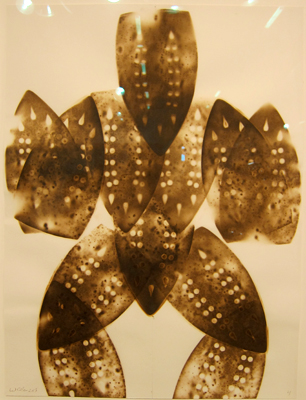
Domus. Dominion. Domination. “Woman’s work.” Heat and pressure. Domestic. Pressed cloth. The draftsman’s Ogun, memory scorched to paper. Go figure. Five Stances for Domestic Defense (2013). Impressment. Brand. Branded. Cutaway views of the death ship passenger cabins. Don’t ever settle for classifications imposed upon you. Get up. Stand up. Consensually limited means as spur to invention. Take that.
_______________
_______________

Many certified and licensed storytellers of art history like to keep their inherited scholarly narrative on top, virginally rooting itself in the highly innovative Greeks of a couple millennia back, (both their philosophical and artistic dispositions – all tightly wrapped since in the military proselytizing practices of Aristotle’s bully student, Alexander) with a few brilliant Italians from centuries ago thrown in and more recently checkpointed with a sequential file of mutually exclusive isms. It’s refreshing that people are more flexible than that (no surprise) and that real dialogue is multidirectional. It’s about a lot more than gold, smallpox, tomatoes, chocolate, corn and beans.
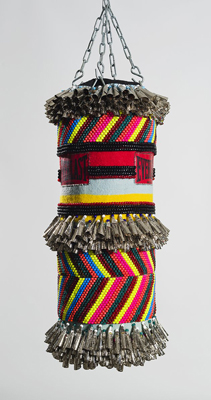
Jeffery Gibson deftly absorbs Pan-European art practices and much else within a totally contemporary Native understanding (one that more than admits that such even exists) with an inventiveness, humor and exuberance on par with Willie Cook’s heroic redemptiveness. Rather than denying the difference of the rest of the world, he includes it, effectively appropriating it into his own “tradition” rather than vice versa. In place of the rectangular window shaped canvas stretcher, we meet an ironing board frame buttressing stretched elk hide or deerskin – which could pass for an ironic postmodern rhetorical gimmick if the multicolored, geometric painted surface weren’t so substantive and compelling. Likewise, there’s something joyously I’m-all-rubber-and-you’re-all-glue about his pow wow regalia (and more) adorned punching bags as occasions for his astute visual sensibility and brisk compositional vitality.
_______________
_______________

It might have been a combination of the slight disconjunctness of his inventions and an exceptional sympathy for handcraft and material. I wasn’t sure what kept me looking at Nao Matsumoto’s sculptures. The Yokohama native has been student of biology before sculpture, visitor to Africa, OWS activist and admirer of the insect world. There was a suspended large fiber reinforced plastic modeling of a blue shark with a long chain saw as snout (Chainsaw Blue, 2012), but there was something about that particular blue and its very particular grade of reflectiveness that really made it exceptional. SAMF-V (2012) is a go-cart sized vehicle that ferries nothing but stacked, beautifully finished wooden spikes. It was the care given the wood that made them matter, but why was it there at all? Their dada-nonsensical improbability with a suggestion of prospective (and headless) velocity and menace rendered them with unusual haunt. Matsumoto can even make clusters of partially drilled-in sheet rock screws look important.
_______________
_______________
Unlike painting, whose all at onceness seems to “stand still” as it allows a viewer to move about freely, the paradox of video’s moving image is that it very often demands that spectators freeze themselves to tunnel vision so that its own sequential unfolding can dominate. Some video may goad viewers into indefinite waiting periods within a not particularly enriched present in some hope that what happens next might just make it worthwhile, all of which may try an observer’s patience or, worse yet, disappoint. What’s more, many gallery and museum presentations, in noble abstinence from the cushie seats of movie theaters routinely leave audiences standing to notice their discomfort all the more while they wait on a video (which must be “important” – or why else would it be there?) to deliver.
Mohau Modisakeng’s elegiac 5 minute video, Inzilo (Zulu for “widowhood”), eloquently builds through some of the more promising potentialities of this medium. Shot in austere black and white and lit with a patient clarity somehow reminiscent of Irving Penn, the first of this series in progress opens with a seated Modisakeng staring directly at the viewer with winglike outstretched arms before a whitish background and floor. A slight camera pan gently rocks his figure into a gradual flight of haunting instability beneath, then quietly zooms onto his hands shaking off rubbled bits of a blackish scaly material that partially encases his hands and arms. In slow motion, he picks and tears at pieces that then fall to the ground, which in a later scene subtly leap from the floor in reverse motion back toward his ankles. He stands up – still in slow motion – lifting his gown to launch the accumulated moulting into the air before him. As pieces arch away toward the floor, a blackish cloud of dust stays to hover directly in front of him.
Modisakeng links his own value and feel for the uncannily telling image with having heard his mother narrate her own gifts of dreams and visions as he was growing up. He continues to hear the aftershock of what, in his view, the majority of South Africans would now prefer to bypass and forget, the still resonating violence of a forcibly imposed social “blackness,” feeling that without deliberately contending with this, the imagining of a yet unseen, restorative future can’t really begin.
The exhibit also includes a number of life size black and white photographs of Modisakeng posed, with similar mediative intensity, quietly wielding weapons of resistance, while dressed in mixed indigenous and European wardrobe in an alertness toward the present legacy and experience of struggle. His direct gaze seems also an interior look into the mirror within which the viewer may also see oneself reflected. All technical distinctions aside, Modisakeng’s commitment reminds me of the searching self examination of Rembrandt’s late self portraits. And, just as one needn’t be versed in the aspirations of 17th century Protestantism or the dominant atmosphere of Dutch mercantilism to “get” van Rijn, Modisakeng plumbs how the South African predicament feels in a way that reaches deep beyond the exact particulars of his own country’s situation.
It could be that the formal strengths of Inzilo as video derive initially from this artist actually having something to say, something to fathom, to contend with and show, versus, for example, trying to find something through toying around MFA fashion dialectics of Western art history. Inzilo allies video’s temporal malleability with the saturation potential of painting by letting each moment, each frame, resonate as an intact and absorbing visual engagement by itself, the whole paced as a poem one longs to hear again and again.
You can even forget you’re standing up.
[ezcol_1quarter]
[/ezcol_1quarter]
[ezcol_1half][/ezcol_1half] [ezcol_1quarter_end][/ezcol_1quarter_end]
Volta NY 2014
Duhirwe Rushemeza, Imigongo #1 (Blue, White, Taupe, Ochre, and Brown), 2013, thin-set mortar, concrete, acrylic house paint, wood and embedded metal detritus, 4 x 4 feet, 5 inches deep. Nomad Gallery. Photo: Arteidolia
Soly Cissé, Untitled, 2013, acrylic on canvas, 59 × 39 inches. Photo courtesy M.I.A. Gallery
Willie Cole, Downtown Goddess, 2013, bronze, 9 x 9 x 36 inches. Photo courtesy beta pictoris gallery / Maus Contemporary
Willie Cole, from Five Stances For Domestic Defense, 2013, iron scorches on paper, 24 x 18 inches. Photo: Arteidolia
Jeffrey Gibson, Shield no. 11, 2013, elk hide over antique ironing board, acrylic paint, graphite, 12 x 47.5 inches. Photo courtesy Marc Strauss Gallery
Jeffrey Gibson, Can You Feel It?, 2013, found vinyl punching bag, repurposed wool blanket, glass beads, tin jingles, artificial sinew, acrylic paint, steel hardware, 16 x 32 x 16 inches. Photo courtesy Marc Strauss Gallery
Nao Matsumoto, SAMF-V, 2012, wood, steel, mud tires, plastics. hpgrp Gallery. Photo: Arteidolia
Mohau Modisakeng, Inzilo [Film Still], 2013, single channel video installation, duration: 4 min 57 sec. Photo courtesy BRUNDYN+

![Mohau Modisakeng, Inzilo [Film Still], 2013, single channel video installation, duration: 4 min 57 sec. Photo courtesy BRUNDYN+](http://www.arteidolia.com/wp-content/uploads/2014/03/video.jpg)